Strange artists in Canada push the boundaries of conventional art, inviting audiences to engage with unexpected forms of expression that often provoke strong emotional reactions. Through their unique perspectives and personal narratives, these artists explore individuality and challenge societal norms, fostering deeper connections with viewers. Artistic freedom plays a crucial role in this process, enabling creators to express unconventional ideas without fear of censorship, ultimately leading to innovative and thought-provoking works.

How do strange artists provoke audience reactions in Canada?
Strange artists in Canada provoke audience reactions by challenging conventional norms and encouraging viewers to engage with unexpected forms of expression. Their work often elicits strong emotional responses, prompting reflection and discussion among diverse audiences.
Unexpected themes
Strange artists frequently explore unconventional themes that challenge societal norms, such as identity, mental health, and environmental issues. By addressing these topics in provocative ways, they encourage audiences to confront their own beliefs and biases.
For example, an artist might use surreal imagery to depict mental health struggles, prompting viewers to reflect on their perceptions of mental illness. This approach can lead to meaningful conversations and increased awareness around sensitive subjects.
Interactive installations
Interactive installations invite audience participation, transforming passive viewers into active participants. These experiences often blur the lines between artist and audience, fostering a deeper connection to the artwork.
In Canada, installations may include elements like touch-sensitive displays or immersive environments that respond to audience movements. Such engagement can provoke surprise and curiosity, making the experience memorable and impactful.
Performance art
Performance art often incorporates elements of theater, dance, and visual art to convey powerful messages. This medium allows strange artists to express personal narratives and societal critiques in real-time, creating a dynamic atmosphere that captivates audiences.
Canadian performance artists may use their bodies as a canvas to explore themes like cultural identity or social justice. The immediacy of live performance can evoke strong emotional reactions, leaving a lasting impression on those who witness it.
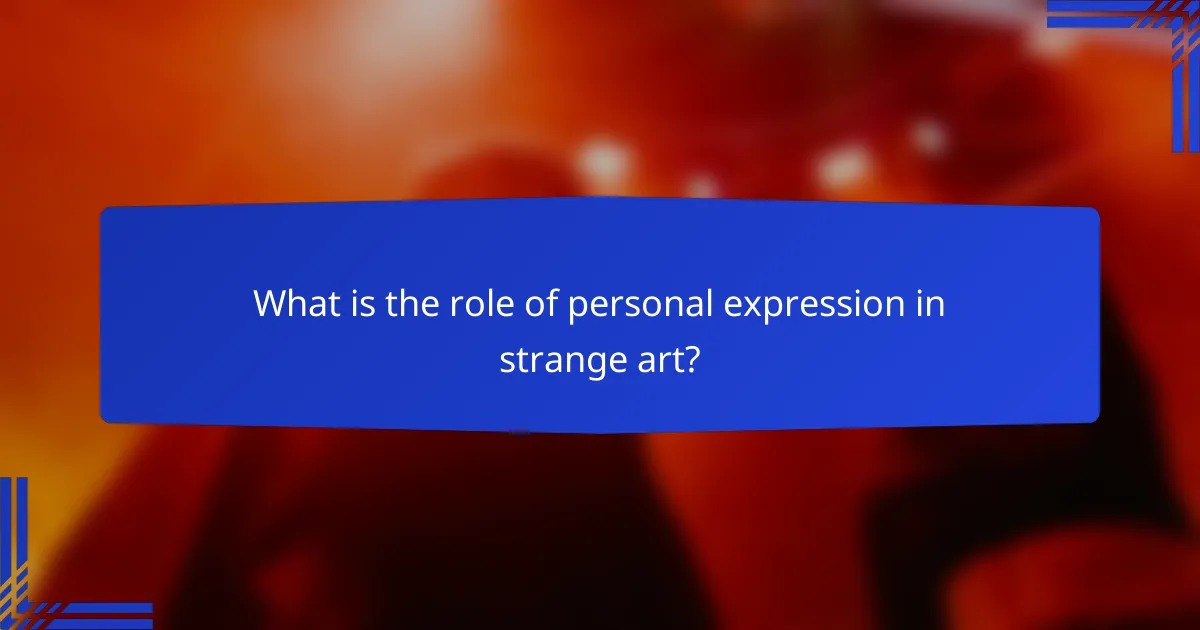
What is the role of personal expression in strange art?
Personal expression in strange art serves as a vital conduit for artists to convey their unique perspectives and emotions. This form of art often challenges conventional norms, allowing creators to explore their individuality and connect with audiences on a deeper level.
Authenticity in creation
Authenticity in creation is essential for artists working in the realm of strange art. It encourages them to embrace their true selves, which can lead to innovative and unconventional works. Artists should focus on their genuine feelings and experiences, as this authenticity resonates with viewers and fosters a stronger connection.
To maintain authenticity, artists can reflect on their personal journeys and incorporate elements that are meaningful to them. This might include using unconventional materials or techniques that represent their unique voice and vision.
Emotional storytelling
Emotional storytelling is a powerful aspect of strange art, allowing artists to communicate complex feelings and narratives. By weaving personal experiences into their work, artists can evoke empathy and provoke thought among their audience. This storytelling can take various forms, from abstract representations to more literal depictions of personal struggles.
When creating emotionally charged art, artists should consider how their choices—such as color, form, and composition—can enhance the narrative. Engaging the audience through relatable themes or experiences can create a lasting impact, making the art memorable and meaningful.
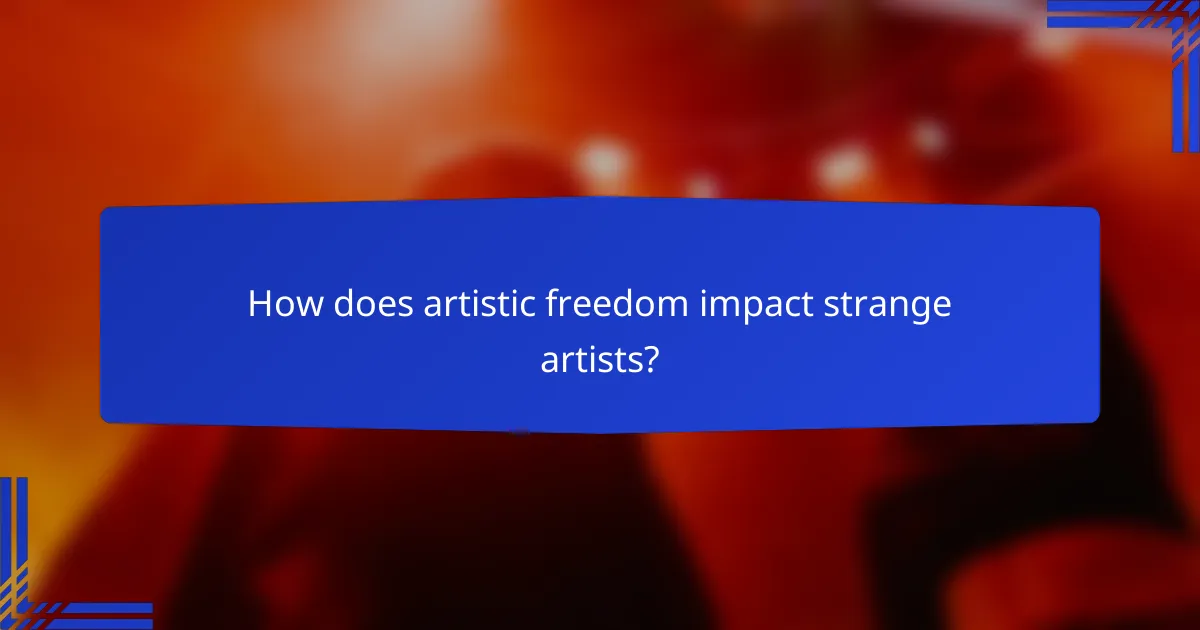
How does artistic freedom impact strange artists?
Artistic freedom allows strange artists to express unconventional ideas and emotions without fear of censorship. This freedom can lead to innovative works that challenge societal expectations and provoke strong audience reactions.
Breaking societal norms
Strange artists often push boundaries by challenging societal norms, which can elicit a range of audience reactions from admiration to outrage. By defying traditional artistic conventions, they create works that prompt viewers to reconsider their beliefs and values.
For example, an artist might use unconventional materials or techniques that disrupt the typical aesthetic experience. This can lead to discussions about what art is and who gets to define it, ultimately expanding the dialogue around creativity.
Exploring taboo subjects
Many strange artists delve into taboo subjects, addressing themes that are often considered uncomfortable or controversial. This exploration can spark intense emotional responses, as it confronts viewers with issues they may prefer to avoid.
Artworks that tackle topics like mental health, sexuality, or social injustice can serve as powerful catalysts for conversation and reflection. By engaging with these subjects, artists not only express their personal experiences but also invite audiences to reflect on their own perspectives and societal norms.

What are the challenges faced by strange artists in Canada?
Strange artists in Canada encounter various challenges that can hinder their creative expression and public reception. These obstacles include public perception, limited funding opportunities, and a lack of institutional support.
Public perception
Public perception plays a significant role in how strange artists are received in Canada. Many audiences may view unconventional art as inaccessible or difficult to understand, which can lead to skepticism or indifference. This perception can discourage artists from pursuing innovative ideas that deviate from traditional forms.
To navigate public perception, artists can engage with their audience through workshops, discussions, or social media. By fostering dialogue and explaining their artistic intentions, they can help demystify their work and build a supportive community.
Funding and support
Funding and support for strange artists in Canada often fall short, as many grants and sponsorships favor more conventional art forms. This lack of financial backing can limit an artist’s ability to experiment and showcase their work. Artists may find themselves relying on personal funds or small-scale crowdfunding to support their projects.
To improve their chances of securing funding, artists should research specific grants that cater to experimental or avant-garde art. Networking with other artists and attending relevant events can also open doors to potential collaborations and funding opportunities.

How do strange artists influence contemporary art trends?
Strange artists significantly shape contemporary art trends by challenging conventional norms and inspiring new forms of expression. Their unique perspectives often lead to the emergence of innovative styles and collaborative projects that push the boundaries of artistic freedom.
Emerging styles
Strange artists frequently introduce emerging styles that defy traditional aesthetics, leading to a broader acceptance of diverse artistic expressions. For instance, the rise of street art and digital installations reflects a shift towards more accessible and interactive art forms. These styles often incorporate elements from various cultures, creating a rich tapestry of influences.
Additionally, unconventional techniques such as mixed media, performance art, and installations that engage the audience are becoming more prevalent. Artists like Banksy and Yayoi Kusama exemplify how unique approaches can resonate with the public, often resulting in viral popularity and critical acclaim.
Collaborative projects
Collaborative projects among strange artists foster a sense of community and innovation within the art world. These partnerships can lead to groundbreaking exhibitions that combine different mediums and perspectives, enhancing the overall impact of the artwork. For example, initiatives like the “Art in the Streets” exhibition brought together various street artists, showcasing their collective influence on urban culture.
Moreover, collaborations often extend beyond the art community, involving musicians, filmmakers, and even technologists. This cross-disciplinary approach not only enriches the artistic dialogue but also attracts a wider audience, making art more inclusive and engaging. Artists should consider seeking out partnerships that align with their vision to amplify their reach and impact.
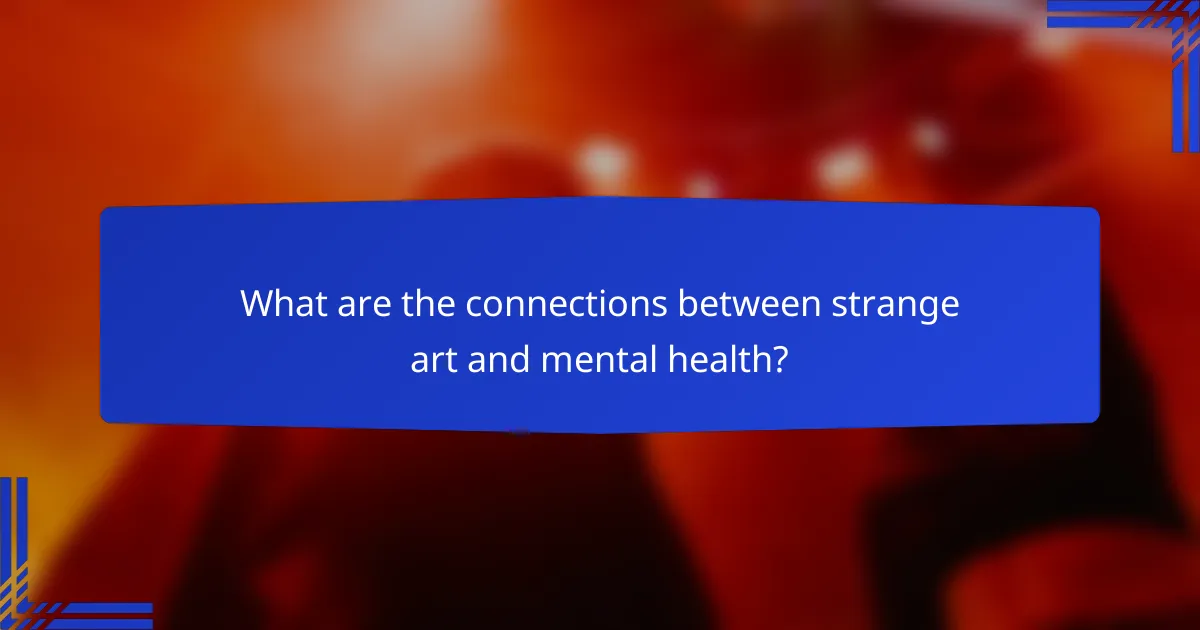
What are the connections between strange art and mental health?
Strange art often serves as a powerful medium for exploring mental health, allowing artists to express complex emotions and experiences. This connection highlights how unconventional artistic expressions can facilitate personal healing and foster understanding of mental health issues.
Art as therapy
Art therapy is a recognized practice that utilizes creative processes to improve mental well-being. It can help individuals articulate feelings that may be difficult to express verbally, providing a safe outlet for emotions. Many therapists incorporate various art forms, such as painting or sculpture, to encourage self-discovery and healing.
In practice, art therapy sessions may involve creating pieces that reflect personal experiences or emotions. Participants often report feeling a sense of relief and clarity after engaging in these creative activities. This therapeutic approach can be particularly beneficial for those dealing with anxiety, depression, or trauma.
Expression of inner struggles
Strange art frequently embodies the artist’s inner struggles, offering a glimpse into their mental state. This form of expression can resonate with audiences, fostering empathy and understanding. Artists may use unconventional techniques or themes to convey their experiences, making their work relatable to others facing similar challenges.
For instance, an artist might create a piece that visually represents feelings of isolation or confusion, using abstract forms and colors to evoke specific emotions. This not only serves as a personal catharsis but also invites viewers to reflect on their own experiences, creating a shared dialogue about mental health.
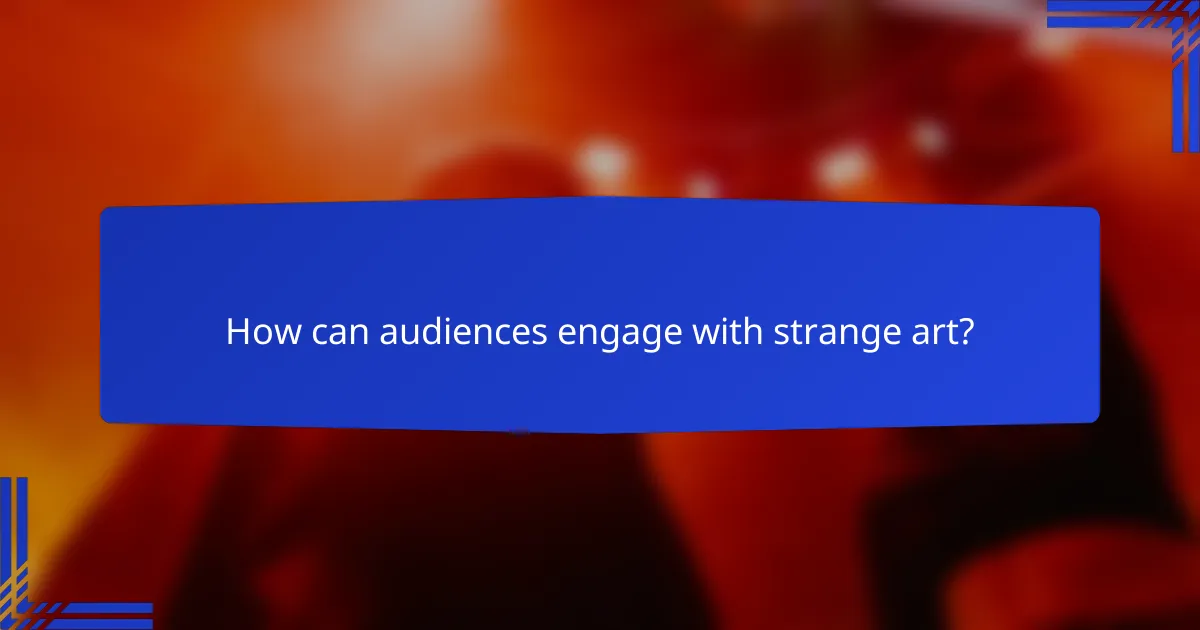
How can audiences engage with strange art?
Audiences can engage with strange art through interactive experiences and digital platforms. These methods allow viewers to connect with unconventional works, fostering personal expression and artistic freedom.
Participatory events
Participatory events invite audiences to become part of the artwork, enhancing their experience and understanding. Examples include immersive installations where visitors can manipulate elements or performance art that encourages audience involvement. These events often blur the lines between artist and viewer, creating a collaborative atmosphere.
When attending participatory events, consider the level of engagement you are comfortable with. Some may prefer to observe, while others might want to dive in and contribute. Look for events that clearly outline participation guidelines to ensure a fulfilling experience.
Social media interactions
Social media provides a platform for audiences to engage with strange art by sharing their reactions and interpretations. Artists often use platforms like Instagram or TikTok to showcase their work and invite feedback, creating a dialogue with their audience. This interaction can lead to a deeper appreciation of the art and its themes.
To effectively engage on social media, follow artists and art communities that resonate with you. Participate in discussions by commenting on posts or sharing your own experiences with the art. Be mindful of the tone and context of your contributions to foster positive exchanges.
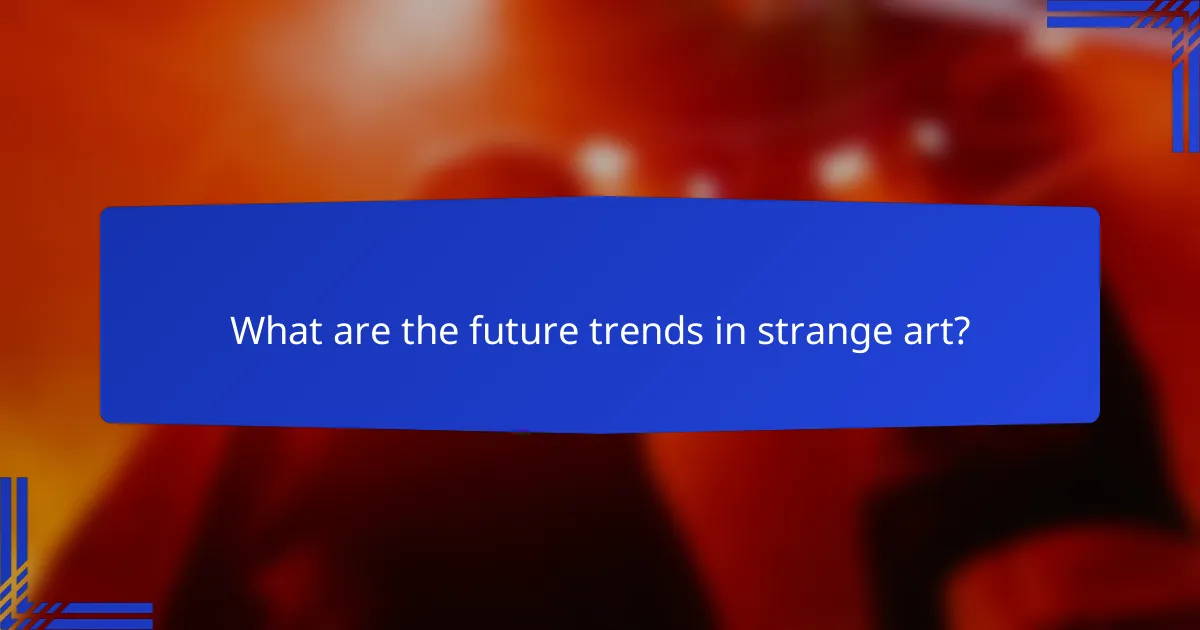
What are the future trends in strange art?
The future of strange art is likely to be shaped by technological advancements and evolving audience perceptions. Artists are increasingly exploring unconventional mediums and themes, pushing the boundaries of personal expression and artistic freedom.
Digital art innovations
Digital art innovations are transforming the landscape of strange art by enabling artists to experiment with new techniques and formats. Tools like virtual reality (VR), augmented reality (AR), and artificial intelligence (AI) allow for immersive experiences that challenge traditional art forms.
For instance, artists can create interactive installations that engage viewers in unexpected ways, blurring the line between creator and audience. This shift not only enhances personal expression but also invites diverse interpretations, fostering a more inclusive artistic dialogue.
When exploring digital art, consider the accessibility of the technology and the audience’s familiarity with it. Artists should aim to balance innovation with viewer engagement, ensuring that the experience remains relatable and impactful.
